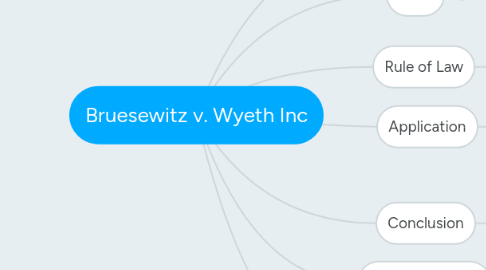
1. Facts
1.1. Bruesewitz
1.1.1. Hannah Bruesewitz, a six month old, received immunization vaccines as recommended by the CDC schedule and began seizures shortly thereafter
1.1.1.1. Hannah was hospitalized for weeks following vaccination
1.1.1.2. Hannah's parents sued for compensation relating to her injuries, alleging strict product liability
1.1.1.2.1. Judge dismissed lawsuit ruling the National Childhood Vaccine Injury Act (NCVIA) didn't allow people to sue vaccine makers, Wyeth in this case, for injuries sustained from vaccines
1.2. Wyeth
1.2.1. Manufactured diphtheria, tetanus and pertussis (DTP) vaccines
1.2.1.1. Vaccines for these three ailments were given to children, in this case Hannah Bruesewitz, who was subsequently hospitalized
1.3. Vaccine market for DTP was blamed for children's disabilities which led to massive tort litigation
1.3.1. A result of this tort litigation was manufacturers pulling out of the vaccine market
1.3.2. The NCVIA set up compensation program that works faster than tort litigation
1.3.2.1. Claimants would receive compensation for medical, rehab, counseling, special ed., and vocational training etc. with $250,000 for vaccine related deaths
2. Issue
2.1. The issue before the court is whether the NCVIA immunizes manufacturers from product liability lawsuits filed by injured parties arising from issues with the manufacturers vaccine
3. Rule of Law
3.1. The rule of law in this case is strict product liability
3.1.1. A plaintiff must prove defective condition, the product is unreasonably dangerous and that physical harm incurred,
4. Application
4.1. The Bruesewitz's alleged strict product liability due to design defects
4.1.1. The court ruled against their claim
4.1.2. The quid pro quo of the NCVIA immunizes manufacturers from liability if they comply with federal requirements, thus eliminating liability arising from unavoidable adverse side effects from vaccines
4.1.2.1. The law provides reparations to the injured parties while allowing vaccine makers to sidestep costly litigation
4.1.2.1.1. This is why the no-fault compensation program was put in place to speed up claimants receiving reparations and sheltering vaccine manufacturers
5. Conclusion
5.1. Supreme Court affirmed lower court decision
5.1.1. Courts found Congress set up special vaccine to compensate injured people without drug manufacturers leaving the market for vaccinations
6. Decision Impact
6.1. Hammitt v. Sec'y of HHS, 2010 U.S. Claims LEXIS 725
6.1.1. In this case, they found that the infant vaccinee's neurologic disorder was not shown to be caused by a DTP vaccination, even though the vaccinee suffered an afebrile seizure lasting more than thirty minutes, within two days of her DTP vaccination. Bruesewitz v. Wyeth is then cited
6.2. Wright v. Aventis Pasteur, Inc., 2011 PA Super 9, 14 A.3d 850, 2011 Pa. Super. LEXIS 6, CCH Prod. Liab. Rep. P18560 (Pa. Super. Ct. 2011)
6.2.1. The trial court opinion in this case notes an inquiry into design defects for a manufacturer's vaccine would require a fact finder to consider the manufacturer's design against a purported safer alternative. Bruesewitz v. Wyeth is then cited
7. Why It Matters
7.1. This case matters because the ruling shelters vaccine makers from excessive tort liabilities, given the nature of their products and difficulty proving a vaccine directly caused the vaccinated harm, and allows them to continue operating in the market without fear of onerous litigation
7.1.1. This case also matters because in subsequent cases, the decisions have been upheld that the NCVIA pre-empts state tort claims regarding design and failure to warn about side-effects like the case of Wright v. Aventis Pasteur or avoiding litigation in situations where it can't be proved that DTP caused seizures like Hammitt v. HHS
